
Russian scientists have developed a nanophotonic-microfluidic sensor that can be potentially used for cancer detection, monitoring and evaluation of treatment response.
The team included researchers from HSE University, Skolkovo Institute of Science and Technology (Skoltech), Moscow State Pedagogical University (MPGU), and National University of Science and Technology MISiS (MISIS).
They designed a miniature sensor device that identifies gases and liquids dissolved in solvents at low concentrations, with a high level of accuracy.
According to the World Health Organisation (WHO), around 30% of new cancer cases could be prevented, and the same proportion could be cured, with their early detection.
The new sensor device is capable of performing complex biochemical analysis, which is believed to be the most promising approach to the early detection of cancer.
HSE MIEM professor Gregory Goltsman said: “Our study is an important step towards creating a compact lab-on-a-chip device capable of not only performing a whole set of blood tests but detecting cancer biomarkers at an early stage using a very small amount of the patient’s blood.
“Ideally, we aim to create a small portable device neded just a drop of blood. By pressing a button, the doctor would see the results, e.g., that the parameters are normal or that further tests are required.”
The new device features nanophotonic optical sensors on a chip, together with microfluidic channels above the sensor surface.
The fluids or gases pumped through the channels impact the propagation of optical radiation in the highly sensitive nanophotonic devices, leading to changes in spectral characteristics.
Based on the changes in spectral characteristics, researchers can determine the composition of the sample.
Human blood contains exosomes, the microscopic vesicles released into the intercellular space by tissue and organ cells, which are important for the preliminary diagnosis of cancers.
Exosomes serve as useful biomarkers in oncology, as blood concentrations increase to reach analytically significant values at an early stage of cancer.
The research team has not tested the sensor on blood samples but on water solutions of isopropyl alcohol in 20 different concentrations, from 0.08% to 72% by weight.
They intend to further refine the device for exosome-based cancer detection.
HSE graduate and paper author Aleksei Kuzin said: “Today, the experimental equipment needed for the device operation is rather bulky. The setup includes a peristaltic pump, a tuneable laser, a photodetector, a chip, and a PC for processing the data.
“In the future, we hope to produce a compact and portable device for rapid testing that will reduce the time and cost of cancer diagnosis, monitoring and treatment response assessment.”






